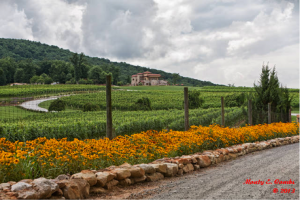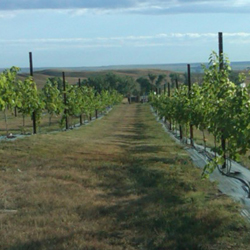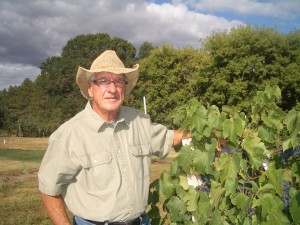Soil Health in the Vineyard
Quality and yield start below the surface
The groundhog predicted an early spring. Then came this year’s winter vortex. Regardless of what happens next, the waning days of winter are a time of excitement and planning for a new season in the vineyard. Plus, it’s a good time to consider how to improve the soil biosphere the vines inhabit.
Soil health has been the buzz across agriculture for the past couple of years as USDA, soil scientists, conservationists, and input suppliers have dished the dirt to stoke this hot topic. Vineyard managers may wonder what the fuss is about. Many have been ahead of row crop farmers several years. After all, vineyard soil almost always presents challenges requiring attention. Even soils ideally matched to the wine grapes growing in them still need a lot of TLC to improve root habitat. From South Dakota to North Carolina, many growers are already in the soil health vanguard.
 Mike Gould has called his family’s Old Folsom Vineyards near Rapid City, South Dakota ‘the miracle on the prairie” in part because of the soil conditions when it was first planted in 2007.
Mike Gould has called his family’s Old Folsom Vineyards near Rapid City, South Dakota ‘the miracle on the prairie” in part because of the soil conditions when it was first planted in 2007.
‘We have very abject calcareous soil,” says Gould, ‘You couldn’t give this kind of ground to a corn farmer. It’s true that this type of soil produces fabulous wine grapes all over the world, but as for here — well, our five acres have always been lacking. We just don’t have that essential black biomass. So to achieve success we’ve had a very serious focus on soil health and vine nutrition.”
A soil that primarily comprises calcium carbonate, lots of chalk or limestone, and some fossilized shells isn’t always a happy place for plants.
‘A major factor in our vineyard management program has been an intense look at the health of the soil and introducing micronutrients and stimulants in the spring that literally feed the organisms in the soil,” says Gould. ‘That’s extremely important.”
Gould says that with healthy soil, root growth and vigor are improved, and more of the nutrients in the soil biosphere are converted by micro-organisms into forms available to the roots. This fuels more root growth and vigor to help mobilize the plant’s own natural protective systems. Healthy soil also promotes an environment less hospitable for anaerobic and pathogenic organisms
Over the years of working with his long-time nutrition consultant Larry Shafer with Agro-K in Minneapolis, Gould has developed a soil health program with BioMax as the cornerstone, though this year Gould may try the newer formulation, BioMax Dual Action +.
‘This soil probably hadn’t been fed any time in the last millennium,” says Gould. ‘When we first put BioMax on we mixed it with molasses to provide long carbon chains to slowly release the nutrition and stimulants into the soil. Within about three days of the soil application you can almost see the vines kick-start like they’ve been turbo-charged. Even with such abject soil we see really good results. Maybe it’s just that the poorer the soil the more you notice it. Regardless, it’s night-and-day after the soil treatment.
‘We do an early spring feeding of BioMax with molasses to the root system. I can’t tell you the biodynamics of it, but I’m a believer that it’s helpful. In fact, it’s probably the most important treatment in this vineyard. We do another four or five foliar nutrient applications during the season, which may include potassium, molybdenum and other nutrients, depending on petiole analysis results.
‘But the most important thing is to kick-start the vines early to stimulate as much microbiological activity in the soil as possible. It’s hard to imagine what’s going on down there, but the vines love it. It also helps over the season because it will bind with the soil for slower release.”
Shafer explains that BioMax is a fermentation-based soil fertilizer containing enzymes, fermentation co-factors and micronutrients. It is a complex microbial food source which stimulates and increases native, existing beneficial aerobic bacteria and soil fungi such as mycorrhizae that are already present in the soil. In the Dual Action version, a complementary seaweed extraction and stabilization technology is added to promote root and vine growth.
‘These technologies work synergistically to build a healthy, diverse rhizosphere and a stronger, more functional root system that is better able to feed the developing berry production,” says Shafer. ‘This improves the plant-availability of soil nutrients and makes the vineyard’s investment in fertility programs more efficacious.”
Old Folsom has more than 2,000 vines of Frontenac, Marquette, Frontenac Gris, Brianna, Nebbiolo, and La Crescent. The latest addition was the new Petite Pearl. The mission is to produce high-quality, chemical-free grapes grown with a sustainable approach and environmental stewardship of the land.
The dedication has paid off. By the harvest of 2014 Old Folsom had seen a 30 percent increase in yield off much healthier soil and vines, Gould says. The vineyard was poised for another bounteous year in 2015 when a ferocious hail storm struck just as the vines were in florescence.
‘We had tremendously healthy vines, and then, in early June, 95 percent of the flowers were knocked off. Instead of 10,000 to 12,000 pounds of grapes, we harvested 1,000 pounds,” Gould says. ‘I knew we were not going to have a crop so I wanted to pour my time and energy into creating very healthy plants going into the winter and setting them up for this spring.”
While stimulating and feeding the soil biosphere is a key part of a soil health program, another component is a cover crop between the vines. The cover crop helps add organic matter and nutrients to the soil, deter erosion, and hold moisture. But many traditional covers for row crops are impractical in hilly vineyards, or even more level ones if they are open to visitors who take tours and who may even volunteer to help with harvest. Grasses that can be mowed seem more suitable to many vineyard managers, and they still provide the soil health benefits.
‘We use a natural cover crop because the vineyard previously was pasture, and prior to that was dinosaur habitat,” says Gould. ‘The ground was hard pan that had never been broken. The only thing we did to it was rip it with a big claw on the back of a Cat to create rows where we planted the vines. You soon learn to appreciate the stone and rock that holds the vines in a firm location — I mean that tongue-in-cheek. The highest point here is the house, and it has four inches of dirt over solid rock.”
Others with more hospitable soil have also seen progress when they’ve included soil health as a focal point of vineyard management.
Ernie Betker’s Trout Brook Vineyard near Hudson, Wisconsin, is on 30 acres of farmland previously planted with corn and soybeans for many years, then turned to hay and cattle grazing.
‘We’ve been gradually converting the land to vineyard,” says Betker. ‘Currently we have more than 12 acres of vineyard with about 5,500 vines. We grow Marquette, Frontenac, Frontenac Gris, Sabrevois, St. Croix, Prairie Star and 2015 was our third year for Edelweiss. We also added Louise Swenson in 2015. We’ve been heavy in reds, so we added some whites.”
The soil health program includes fall soil and fertility treatments in addition to spring applications.
‘This spring we’ll put on our usual root feeding of 3-18-18 plus BioMax Dual Action+ at two quarts per acre with a couple of gallons of molasses per acre to help with organic matter in the soil,” says Betker. ‘The same application goes on in the fall, with two additional applications. One is sprayed while there still are leaves on the vines. The second may go on after the leaves are down because the material we use can be absorbed through the wood. It helps harden off the vines for health during winter. Adding liquid potassium to one of the applications every other year or so helps deliver a little more of that nutrient to the soil.
‘This winter I’ve observed that the vines look good and healthy, and they should stay that way if we don’t get another winter like we had with the 2014 Vortex. In 2013-14 we had below zero temperatures for 50 days. Some people had no crop. We were able to harvest 39 to 50 percent of a typical crop. We usually have 30 to 35 tons and in 2014 we had 14. In 2015 we had 42 tons, our best year. It takes healthy soil and vines to make a big, high-quality crop like that.”
Betker does tissue sampling twice a year to adjust the foliar fertility program. Soil testing is every two years, with Midwest Laboratories in Omaha, to get a reading on any deficiencies that are showing up. Betker goes over those results carefully and develops remedial steps.
‘We do the root feeding religiously every spring and fall regardless of what the soil sample tells us because we’re also focused on the health of the vines,” Betker says. ‘Also, about every two years we add 200 to 300 pounds of potash to the vineyard soil with a banding spreader. We always seem to be short of potassium in the soil.”
Betker maintains grass between the rows of vines, which also helps impart some additional nutrients to the soil while encouraging the health of the micro-organisms.
‘The biosphere treatments act like an agitator in the soil,” says Betker. ‘They accelerate microbial action that helps roots take up the nutrients, and that a good thing. The soil and the vines need something like that every year.”
Andy Shores, who manages the Raffaldini Vineyards near Ronda, North Carolina, has 43 acres of sometimes challenging soil he hopes to improve each year. The vineyard is nestled about 30 miles west of Winston-Salem in the Yadkin Valley and Swan Creek area. The land resembles the winemaking regions of Central and Southern Italy with rolling hills, rocky schist-based soil, gentle breezes, and constant sun across northern and eastern inclines, with excellent drainage.
‘Most of our good, older blocks have rocky and sandy-loamy soil, but we also have one block with that old Southern red clay,” says Shores. For 2016 he plans to try BioMax Dual Action + in the red clay to see how the vines react. In 2015 he used the treatment in the other blocks and was generally pleased with the results, though he wants a couple more years of testing to feel more comfortable with the newer mixture.
The vineyard website (www.raffaldini.com) describes a holistic spray program relying heavily on organic and natural treatments for nutrition and pest control, as well as treatments to stimulate and improve soil health.
The soil health program begins in mid-January with applications of compost Shores creates using the pomace, grape skins, leaves and grass clippings.
‘There’s never enough of it so we buy some compost as well,” Shores says. ‘We spread that under the vines so when we get snow or showers it will soak in slowly. The best time to apply it is during our down time in winter so tractors can get through on firm ground.
‘We can’t do a traditional cover crop because with so many storms each year there would be too much erosion if we tried to till it and put in a crop. So we just have fescue there. We keep the ground under the vines bare except for the compost.”
The soil biosphere treatment begins at bud break, which can come any time between the third week of March and the second week of April. The mixture will be BioMax Dual Action+, molasses, and a blend of micronutrients. The treatment will be applied through drip irrigation and will be repeated at least once a month, depending on whether there has been too much rain or water is in scarce supply.
‘For years we were just using Symbex and molasses, then we went with Symspray, 3-18-18 and molasses, with some Micro-Mix DL if needed. Then we were using BioMax. Now we’re switching to BioMax Dual Action+, which has added the seaweed-based technology they developed for Symbooster 10X. The vines look great and I’m interested to see results over the next couple of years.”
Shores said he already has seen how well young vines respond to soil treated with BioMax. This is an important need at the Raffaldini Vineyard.
‘We don’t have a lot of vines that are 15 or 20 years old,” he says. ‘A lot of ours are 2, 3 or 4 years old. Some of that is because of winter kill and some is because we experiment with different varieties. When we first started, we didn’t know what Italian varieties would grow here. It’s not like California where you could just ask a neighbor, so we just did trial and error. We’d experiment by planting one or two acres, then pull it up and try something else. We were the first one on the East Coast to plant Vermintino and Montepulciano. Now we are down to nine varieties.

Gloriosa Daisies, ubiquitous in the Tuscan countryside, envelop the 120 acre Raffaldini Estate. In the background is Petit Verdot.)
‘Our young vines have really taken off in response to the Symspray, 3-18-18, molasses and Micromix DL we used since 2009. And more recently, BioMax. We get some crop as early as the second year, and we get a big crop the third year. Usually you wouldn’t expect more than a light crop that third year.”
He said that in 2014 when newer vines were just two years old, some had three clusters per shoot.
‘We dropped them to one cluster per shoot and wound up dropping more than we kept that year,” Shores says. ‘I’ve been managing this vineyard since 2002, and I’ve never seen 2-year-old vines have that much fruit on them. Something made the difference, and I believe a lot of it was better soil health.
‘This year we again will be starting some new plants, and we’ll give them the soil treatments starting at bud break, usually about the first or second week of April and continuing every 2 to 3 weeks. They usually get several treatments during the season.”
This article was sponsored by the Agro-K Corporation in Minneapolis
For more research regarding vineyard soil health, click here





